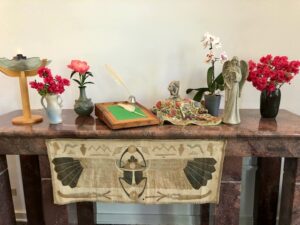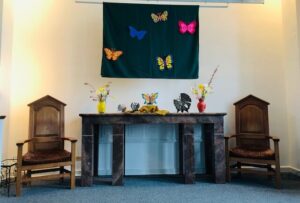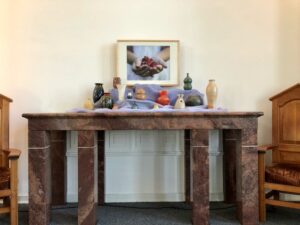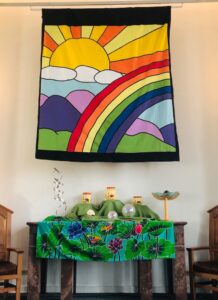INTRO
We are just a week and half away from the first day of spring. The world around us is doing its annual transformation. And we humans have a chance to think about transformations in our lives, also. The butterfly is a class example because of its change from egg to caterpillar to chrysalis to butterfly. But we humans are different because we have some conscious thought about the choices we make. Sometimes this conscious thought gets in our way, and sometimes we can use it for the better.
STAGES
The stages of the butterfly involve stillness and action, eating and not eating, and have very different appearances at each stage. We humans, too, if we let ourselves, have stages of stillness and action, eating and not eating, and might be very different in emotional and spiritual ways at each stage. These transformations are about fulfilling a potential and making way for the next generation.
OBSTACLES
But I’d like point out two obstacles that can get in our way.
1) The first obstacle is when we think that other people can do our transforming for us. For example, thinking that the tax accountant is responsible for one’s financial well being or that the parole officer is responsible for one’s legal status. In truth, each of us is uniquely capable of going through the processes of evolution and growth toward our potential.
Of course, we do need to be in relationship and often in collaboration. There are some areas of life that are defined by relationship, where we are not acting alone. So, in marriages, in churches, we live with a creative tension: how do we go through changes while staying in relationship?
Another twist on this is by thinking that if other people would just get out of our way that we could finally have that transformation. We think that if others would just get out of our way, we could develop, could change, could grow, could save the world. We think that if we just had the right teacher, right partner, right foster parent, right minister, right president, then things would flow for change and goodness. This is a fallacy.
Now, it is of course true that society and culture have unjust leanings and inherent biases. But if one so gets accustomed to doors being closed, so jaded that one can’t see when a door actually is open, then one misses an opportunity to walk through it.
And so, to overcome this obstacle, we need to keep that fine balance of any human living with other humans: be our own unfolding self while keeping in relationship with others. This is a life long learning.
Now, there’s a second way that I think we accidentally put up obstacles to our own transformation.
2) That is by letting technology interfere with natural unfolding and pauses. Now, throughout human history, humans have come up with new tools and machines to help with production, with entertainment, with easing life. But these are not the same as the natural unfolding of potential. Increasing production potential is not the same as allowing natural potential. Throughout human history, we have had to ask again and again, with the development of each new technology, how can we use this new tool in ways that are moral, are for the highest good, and not to interfere with the unfolding of the soul?
Today we see the role of cell phones in the lives of youth. Doctors have been documenting the reality of media addiction and the chemical processes in the brain that limit emotional connection and learning after too much screen time. Phones do not teach stillness. Just like the chrysalis was still inside the cocoon, each of us needs to learn the capacity for stillness.
So, what we as adults can offer the next generation, and ourselves, is the discipline to use technology thoughtfully instead of addictively. And then to expose kids to natural transformations such as planting a garden, sitting quietly by a pond, observing snowfall turning to sleet turning to rain turning to mist. Good old fashioned sitting still. The ancient art of being quiet. Just like the egg before it became a caterpillar and the chrysalis before it became a butterfly.
We need to ask ourselves again and again:
Just because you have the tool to do something, does it mean you should?
What if it interferes with life, interferes with the miraculous unfolding of things…or, what if it interferes with death, the miraculous change at the end of life?
This raises the question about the tools of modern medicine. We have amazing new ways every year to slow disease processes, to ease pain, and sometimes to reverse the dying process. But is that good for us? Families often fear losing their loved one, and fear not trying hard enough to keep them. But like all wisdom in this life, there is a balance of logic and emotion in choosing when the machines are getting the way of a natural death, a natural process.
So, to help with this challenge, I suggest letting kids be around death…soothing the pet as it takes its final breaths, digging the hole to bury the pet. Visiting people who are ill and focusing on the love inside that connects us. Give the next generation practice at the rites of passage as a body finishes its time in this physical form.
This leads me into the second part of this sermon, which is about what we can do to help transformations go well. Here is the good news: We can nurture people.
BALANCE WITH NURTURE
The caterpillar was nurtured by eating the leaves. The chyrsalis was nurtured by the protection of the cocoon. The butterly was nurtured by drinking water and nectar. The egg was nurtured by deep processes while time was passing.
For these creatures, the change seems to just happen, but for we humans, with our thinking minds that can anticipate problems or remember the past, change is uncomfortable. People need a nudge, need some cheerleading, need some reassurance. Yet, as always, The question of balance is always at play in life.
Too much nurture = stagnation; not enough doesn’t allow.
Here is a story that illustrates: Here I told the story about Michelle Obama learning the and how her aunt helped her. From the book Becoming by Michell Obama (2018) pp 3-16, esp pp 15-16.
STORY
I shared that with you because it shows how the aunt, who was also the piano teacher, gave her enough nurture to help her tolerate the work of learning the songs. She gave a place to share her music. And when little Michelle lost her way, her aunt gave her the littlest bit of direction and then got out of the way.
Who are you responsible for in your life? Employees? Offspring? What are you doing to challenge them to be open to change, and nurture them to tolerate the discomfort of change?
Now, as with any issue, we must ask: What are the issues of equity and equality around nurture? These are value based questions as we seek a world in which people can unfold and realize their potential. Not everyone has the same access to resources, and so some people’s transformation may be limited. But limited is not the same as blocked. But when we look at social and economic structures, we need to look at where some people are getting nurture and some people are not. As an example, the local project called Play Partners gives extra time to give a reading buddy for a child. Also as an example, when our congregation used a learning curriculum called Beloved Conversations, the adult learners were given some nurturing support even as they grappled with challenging reflections about race—but not so much as to make them fragile or dependent.
This is true not only for individuals learning, but for groups. I credit this idea to a book by Roy Oswald and Barry Johnson, called Managing Polarities in Congregations: Eight Keys for Thriving Faith Communities. (2010, Alban. New publishers: Rowman and Littlefield.)
These authors have spent time serving congregations and organizations. They have seen natural cycles as congregations are formed, grow, and change. Here is one phrase from the book that made my spine tingle: “Letting conflict ripen.” They are not talking about letting conflict become quicksand, not about dangerous heat or uninformed sharing. The word ripen connotes that a change is occurring which will lead to new fruit. They suggest that We may not be able to direct the outcome of a group process, but we can remain committed to being curious and to not clinging to comfort and security at the expense of unfolding into something more meaningful and value-based. These authors explain that Whatever we learn in our personal lives also applies to our group lives—if we are bracing against transformation in our personal lives, we may also be doing it in our community groups. When we learn to live with the discomfort of growth and change, all sorts of possibilities open up. We still need to be values based, and we still need to be skillful.
And hearing these author’s suggestions, I reflect on how we can do that. I think that Spending time in this sanctuary is one way to allow the quiet, just like the egg, just like the pupa/chrysalis. It is passive, but in a mysterious way is also something is active.
This is a fine balance my friends, a life-long learning.
And, so, we find ourselves with the need for a broad perspective, standing back enough to look from the balcony. I like the word from ancient yoga philosophy: sraddha: oh you who can see more than I can, help me to know the way. When to be still? When to fly?
Our opportunity is to thrive by having both nurture and transformation in our lives.
May we step forward. May we be patient, open-eyed, and curious.
Blessed be.
Amen












